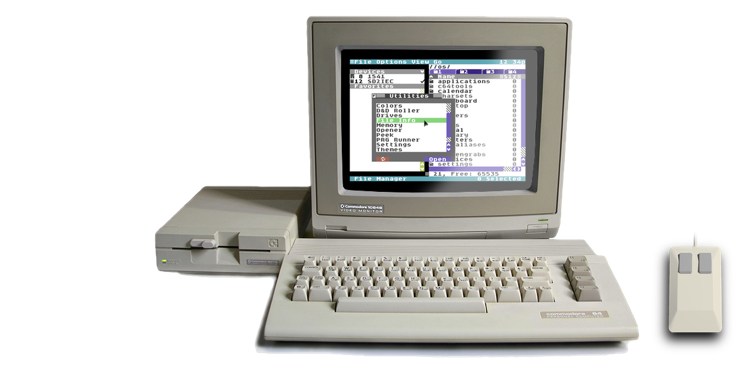Content
- Welcome Page
- Order C64 OS
- C64 OS User's Guide
- C64 OS System Updates
- Weblog Full Archive
- Commodore 8-Bit Buyer's Guide
Of course our all-in-one has to have a handle on the top, that's what makes it luggable. In the end this luggable C64 will be quite hefty. So it's important that we get a handle that is robust. I chose a nice, solid, brushed aluminum drawer handle with a fairly wide split (5 to 6") between where it is attached to the top plate. In the images below, you can see the handle I chose. The first thing I did was position it and also mark some guide lines for where I want the display's top ventilation to be.
Besides the ruggedness of the handle itself, a pretty big concern is that the entire unit does not fall apart when picked up by the handle. Remember, all of the weight of the entire thing will be hanging from the top plate. That top plate is made of a fairly wide (14 1/2") sheet of glued together pine wood, which itself is only 3/4" thick. If all the weight were pulling up from the middle of that piece, it would likely bow, and could break. Having the handle have a wide base means the weight is distributed across two points and out from the middle towards the sides.
I was still concerned with the strength of the top plate however, so I opted to reinforce it with steel L brackets on the underside.
The L brackets actually serve two purposes. They reinforce the strength of the top plate itself, preventing it from bowing under the weight of everything. But, they also serve as the washers for the metal screws that go right through the top plate and into the handle. If I hadn't used these L brackets, I would have had to use large round washers on the underside to prevent the screws from tearing through the wood. With the L brackets, this was unnecessary as the handle's screws pass through two of the three holes on each of the L bracket's one side. I had to buy longer metal screws for the handle. The ones that came with it were 1/2" too short to pass through everything I have them pass through.
The position of the L brackets was measured out such that their middle holes would be exactly the distance apart that the handle's mounts are, and allow the handle to sit in the center middle of the top plate. Now, the brackets themselves are in two halves, so they don't reinforce the top plate entirely all the way across. However, when you attach the handle, the handle itself is so robust that it serves to bridge the gap between the L brackets.

One problem you can see with the right bracket in the picture above. The two arms of the L brackets are equally long, but when the arms stretching across the inside of the top plate are positioned as they need to be, the arms running front to back are too long. So, I needed to shorten them which I did using a dremel. In the image above the left bracket has already been shortened, the right is marked at the place to cut off.
Clamp one of the brackets to the workbench. Using a dremel with a pipe cutting bit you can cut through the steel bracket with not too much effort. But if you want to preserve some of the dremel bit you only need to cut a little over half the way through. After that you can bend the piece back and forth a couple of times with a pair of pliers and break it off with metal fatigue.
The display sits inset into the upper front portion of the chassis. But when all is put together the inside of the chassis will be more or less sealed, and the edges all around the display will be within the wood frame. This could lead to an overheating problem with the display, because its own back top panel is full of ventilation slits.
Inside the chassis, above the display, is nothing but empty air space that leads up to the inside of the top plate. So I decided to put some tasteful ventilation holes directly through the top plate. I don't believe it will have any negative impact on the strength of the top plate, especiall ywith the reinforcement from the L brackets.
The top plate actually rests partially over the 1/2" thick rim of the display itself. So approximately midway between the front and the handle I measured out three rows of holes, about 1" apart and staggered to look nice. There are 37 holes in total. The middle row as 13, and the front and back rows have 12 each.
The other thing you can see in the photos above are two small L Brackets of a different sort. The previous L Brackets will prevent the top plate for bowing under the weight. However, all the weight still hanges from the top plate, which is connected to the sides via the 8 wood screws described in the section about the main chassis assembly above. This should be enough, but for a litte extra support I added in two small L brackets that link the top plate to the side panels.
And that about does it for the handle installation and the upper ventilation.
Below you can see a cross section of how the handle connects through the top plate to the reinforcing L Brackets below. And lastly, the glory shot of how it will look from the top outside. The handle can easily be removed before painting will begin and put back on after. My only final thought is that the holes of the top ventilation may not be large enough. If I find that they don't allow enough air to pass through I may consider enlarging them by one bit size.
Last modified: Sep 20, 2022
This is a living document. The table of contents is a work in progress, and the content is only partially written. It will continue to be written as the project continues to be worked on.
Copyright © 2025 OpCoders Inc.
Commodore 64 and the Commodore Logo are registered trademarks of Commodore Business Machines, to which C64OS.com has no affiliation.
C64OS.com is powered by Ultralight Blogging Platform.
Instant SSL
